Analyzing Intel Core M Performance: How 5Y10 can beat 5Y71 & the OEMs' Dilemma
by Brett Howse & Ian Cutress on April 8, 2015 8:00 AM ESTCinebench R15 Single-Threaded Results
Cinebench will run the CPU up to 100% load for the duration of the test. As this is the single-threaded run, only one core will be active, which should in theory provide more headroom for that one core than when all cores (physical and virtual) are loaded. There is no burst workload here at all, and sustained single-threaded performance is the key for this test.
The Core i5 does exactly what would be expected for this benchmark. With just a single core loaded, the cooling system has no issues keeping the CPU from throttling. It maintains an extremely consistent CPU frequency during the run. This cannot be said of the two Core M-5Y71 devices though. The Dell Venue 11 Pro starts off with quite a high frequency, but as the temperature increases, the CPU drops in frequency to keep below the threshold of 90°C set on the SoC. At any opportunity, it increases its CPU frequency to try to increase performance, but generally that does not last for very long, and it ends up falling back down. The Yoga 3 Pro on the other hand, has a much lower allowed SoC temperature, with Lenovo locking in on 65°C as their maximum target temperature. This keeps the frequency down.
The ASUS Zenbook has an entirely flat CPU line though. The excellent heat dissipation of the chassis allows it to run for the duration of the benchmark with no throttling at all. It has to be noted though that the maximum CPU frequency is a quite a bit lower than the 5Y71 devices, topping out at 2.0 GHz versus 2.9 GHz for 5Y71. It would be very interesting to see how the UX305 would do with the faster CPU inside, and if it would run into throttling issues as well.

Looking at the average CPU frequency over the run shows that the i5 clearly has the most headroom, which is not surprising. Averages are only part of the story though, with both of the 5Y71 devices being able to jump past the 5Y10's frequency several times during the test.
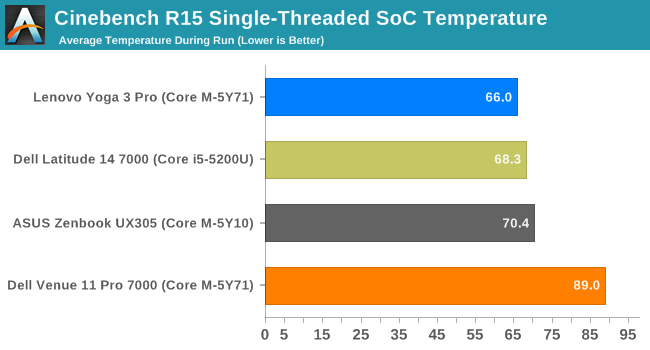
Looking at temperatures, it's interesting to note that the Dell Venue 11 Pro has the top-tier Core M-5Y71, but it puts that processor in what is the smallest chassis and with a plastic exterior. Consequently it quickly loads up to its maximum temperature and stays there for the duration. The rest of the devices stay much cooler with just a single core loaded.
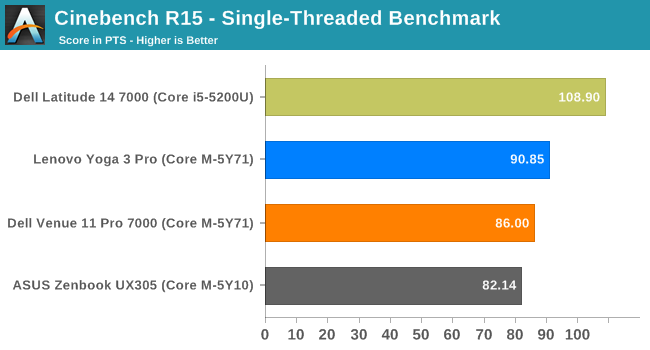
Here we have the actual benchmark results. On single-threaded workloads, the 5Y71 can and does outperform 5Y10. Despite the average CPU frequencies being lower on both 5Y71 devices, they had enough headroom when necessary to jump past the very consistent 5Y10. None of them can match the Core i5 in this test. It is actually very interesting that the highest scoring Core M in this test has the lowest average CPU frequency.


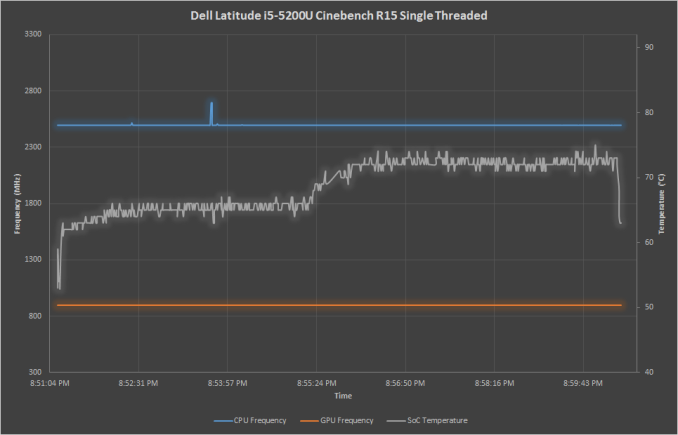
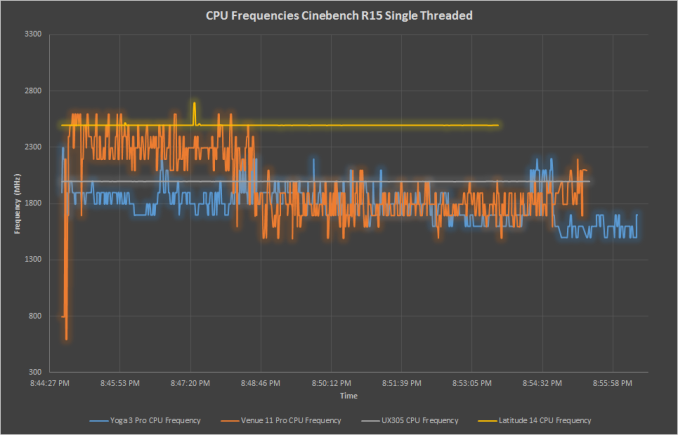
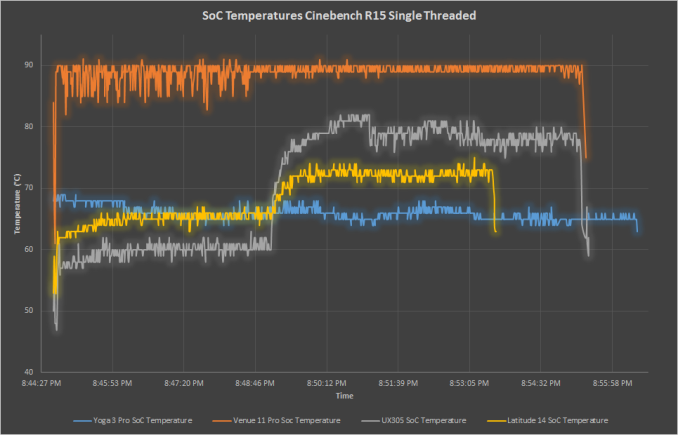








110 Comments
View All Comments
zepi - Wednesday, April 8, 2015 - link
Surface pro 3 is ~50% thicker than iPad Air 2, weights ~50% more, has active cooling and still has poorer performance than Surface Pro 2.From my point of view Surface pro 3 proves that Haswell-U can't power ultra-thin x86 tablets.
lilmoe - Wednesday, April 8, 2015 - link
Didn't know the iPad was an ultra-thin x86 tablet that replace your laptop. Good to know, thanks.I get that the iPad has a huge fan base, I really do. But would you guys please stop comparing it to real PCs in tablet form already??
zepi - Thursday, April 9, 2015 - link
Central argument proposed was that SP3 somehow proves that Haswell-U can power ultra-thin X86 tablets. There were no mentions about Windows or OSX compatibility in original statement.Keyword is Tablet. x86, ultra-thin etc. are describe terms. You don't need to go far and see that the statement is clearly false. Ultra-thin in context of tablets means these days that thickness of the device should to be somewhere around 6-7mm. SP3 is 9mm. I picked iPad Air 2, because it is the most well known of competitors. We could just as well use Dell Venue 8. Ipad thickness is 6.1 and Dell is 6mm thick. Later is even x86 and runs windows
Weight was another thing. Naturally comparing weight to Venue 8 makes very little sense since SP3 has over twice the total screen area of Venue 8 so I compare it with iPad air 2, which has the biggest screen area of the most well known tablets in the market. Most certainly, there are some less well known 12" models, but they are not widely spread and have hardly any market penetration.
I cannot see how SP3 would prove that 15w TDP allows for compact tablet designs. SP3 is already thermally limited and mostly proves to me that in order to reach smaller and thinner designs, lower power SOC's are necessary. From my point of view SP3 is full computer which offers decent (though arguably best in class) tablet usability in addition of being dockable general purpose PC-computer.
digiguy - Wednesday, April 8, 2015 - link
come on, you change the comparison in the same sentence, SP3 is thinner and lighter than SP2, and has has higher res screen. As for ipad air, try to run Windows on it....Jaybus - Wednesday, April 8, 2015 - link
Or even if it ran OSX. The iPad is a giant iPhone. If it ran OSX, then we could compare it to SP3. For now, iPad can only be compared to Android tablets.xthetenth - Wednesday, April 8, 2015 - link
Being thicker than slower devices and slower than thicker devices only proves that it fits between them on a size/performance scale and does nothing to show that it's not a good device.ppi - Wednesday, April 8, 2015 - link
My desktop is also thicker than iPaid Air2, weighs more, has active cooling and certainly eats more power. So ... ?You have to realize, that this 4.5W chip actually has performance that is in league with 15W chip. For many ultrabook/2-in-1 use cases ideal chip. And read the Yoga3 review, where on CPU-bound benchmarks, Core-M runs circles around A8X.
frozentundra123456 - Wednesday, April 8, 2015 - link
I agree with some of the other posters. The problem is the price of these devices for the performance. I can see them for say business use, where the company is paying, use is light, and mobility is important (say for a sales rep who travels a lot), but otherwise, I cant see Joe Average Consumer paying north of 1000 for these when you can get similar perrformance for less in a 350.00 conventional laptop or less performance, but still decent in a 100 to 300 dollar atom device.xthetenth - Wednesday, April 8, 2015 - link
The ASUS is in the 700 dollar range and avoids a great many other compromises cheaper devices would make. It fits into the price/quality scale very nicely.zepi - Wednesday, April 8, 2015 - link
From gaming / usability perspective the average-results do not necessarily tell enough.Ie. does the usage experience of certain devices suffer because GPU / CPU throttles too much under certain loads?
Are the bottom 10% frametimes so horrendous on throttling devices that DOTA-gaming is practically out of question despite relatively small difference in average frame rates?